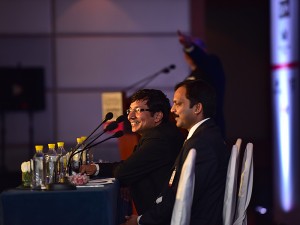 The Automotive Logistics India conference presented positive signs that India may be on the right path to improving economic performance and development in critical areas of logistics, including multimodal. But as ever, the pace is slower than many would like. Marcus Williams and Christopher Ludwig report from Delhi
The Automotive Logistics India conference presented positive signs that India may be on the right path to improving economic performance and development in critical areas of logistics, including multimodal. But as ever, the pace is slower than many would like. Marcus Williams and Christopher Ludwig report from Delhi
The tragic and historic floods in Chennai have had a serious impact on India, with many people losing their lives and considerable damage across the city and region. The supply chain has been disrupted as well, with many suppliers and most carmakers in the area having to shut for some period, including Hyundai Motor, Ford and Renault Nissan. Many attending or planning to attend Automotive Logistics India in Gurgaon, outside New Delhi, were either directly or indirectly impacted.
However, the rains, though devastating, are unlikely to be enough to disrupt the India’s trajectory and long-awaited recovery. Following nearly four years of stagnation or slow growth in sales and production, India is set to return as a key growth market in global vehicle sales and trade over the next six years. Stable politics, strong GDP growth and low commodity prices look set to drive the industry forward. However, to fulfil its potential the country needs concerted action between industry and government on a range of issues from lagging infrastructure improvements to costly inefficiencies in the movement of goods.
“For years we have said that the ‘wolf is at the door’ with the GST,” said Prem Verma, chief executive officer at TML Distribution Company, the vehicle logistics arm of Tata Motors. “Now we are starting to say that the ‘wolf is getting tired of waiting.’”
The logistics costs of India’s poor infrastructure remain high, according to Julian Bevis, member of the infrastructure committee at the Federation of Indian Chambers of Commerce and Industry (FICCI). “Progress is being made but the fact remains that logistics costs represent 15% of the country’s GDP compared to competitor markets where it is half that,” noted Bevis. “That is a significant economic distortion.”
That substantial disparity is exacerbated by inefficiencies in the logistics chain said Bevis, which can account for anything between 30-40% of total landed cost of moving a product, equivalent to an extra $3,000 per container. Reducing total trade costs by 10% would see a growth in exports of 8% and add export value of more than $3m per year for the automotive industry.
On the cusp of a new growth wave
However, Verma and others at the conference had not given up hope in the market or India’s logistics, pointing to positive signs in the economy and in the wider automotive logistics industry. According to figures from automotive analyst firm, Jato Dynamics, the Indian economy has emerged as a global leader in growth this year, with 7.1% GDP expansion and 7.4% expected in 2016, outpacing China’s expected pace both years, according to Amit Kaushik, Jato’s country head for India.
The vehicle market has been somewhat slower, but has returned to low single digit growth in 2015 compared to 2014 following declines, though passenger car sales are still hovering around similar levels since 2011. This year, light vehicle sales are expected to hit 2.6m and total vehicle production around 3.1m units.

Sales have varied among carmakers, including strong growth for Maruti Suzuki, Hyundai and Honda, and others who have lagged. “There has been a revival in India and there are many good signs, but it not to our expectations,” said Prem Verma. “As I said last year we are playing a test match, but we are impatient.”
However, starting in 2016, growth is expected to pick up, rising 9.5%. Production should reach 3.4m and expand steadily; by 2022, Jato forecasts vehicle sales reaching an optimistic 5.8m, with 4.9m made up of passenger cars.
India is also set to see more positive news for its vehicle exports. Already, light vehicle exports have expanded in 2015, despite the country’s overall export figures declining by around 20% on the back of weak global trade. Vehicle exports are on pace to reach around 600,000 this year, driven by Hyundai, Suzuki but also rising exports from Renault Nissan, Volkswagen, Ford and others. Jato’s Kaushik predicted exports would reach around 900,000 units by the end of the decade.
That growth has prompted good developments, including on the port side for India. For example, at the port of Pipavav, in Gujarat, NYK and APM have launched a new car terminal, which is already serving Ford’s new plant in Sanand. And likewise, there have been good developments at the Mumbai Port Trust, where collaboration between the government-owned port and WWL has helped to improve operations and to revive a port that was expected to be closed and be turned into commercial real estate only a decade ago. Today it is handling close to 200,000 vehicle exports per year, largely for vehicles from Maruti Suzuki, but also from the Pune cluster, including Volkswagen, Tata and GM.
“This development is really fantastic, and we need to find a way to replicate such collaboration across the industry,” said Verma.
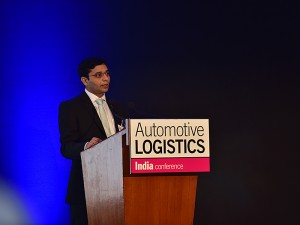 Jato's Amit Kaushik predicts vehicle sales will grow by nearly 10% in 2016
Jato's Amit Kaushik predicts vehicle sales will grow by nearly 10% in 2016A market in flux
While India remains a ‘frugal’ vehicle and logistics market, there are ways in which it is changing, both among customers as well in logistics costs. Significantly, India’s hatchback and SUV segments are forecast to grow, said Kaushik, expanding along with India’s traditional small, B-car market, sales of which sit just short of 800,000 at the moment. The growth of the sub-compact car will hit 1.2m next year, while SUVs move to around 550,000, both of which have implications for supply chain and logistics. Higher-end hatchbacks, for example, are around 300% more than the average entry vehicles, a reflection of India’s growing middle class. That said, entry-level buyers make up the greater percentage of sales in India and the small car market is by no means shrinking fast. Those moving from the massive 2-wheeler market – which is also expected to grow – are also likely to keep the small car segment strong.
There are also shifts expected in the competitive landscape. Maruti Suzuki has a 41% share of the market this year (which has increased from 39% since 2014 on the back of strong sales), though rivals such as Hyundai and Honda have also seen strong growth on the back of their strong SUV sales. Jato’s Kaushik predicted this would shift over the next six years, with Maruti’s share falling to 27%, largely as smaller carmakers grab share from it and from Hyundai, which is currently the number two player in India at 14%. One example is Renault-Nissan, which could double its 3% current share over that time to 6% in 2022, while Toyota and Ford are also expected to gain share.
However, that outlook was questioned by Jasjit Sethi, CEO of TCI, India’s largest automotive logistics provider, who pointed out that the carmakers’ network across the vast country had to be taken into account, both in terms of dealerships and the distribution of spare parts. That coverage is not likely to be challenged significantly in the foreseeable future, especially if there are multimodal improvements, giving Maruti dominance in the market for some time to come.
There are other shifts underway in India that could directly impact logistics cost and providers, India still has structural and economic issues, said Kaushik. While much-needed infrastructure conversion is painfully slow, there are positive developments ahead on both the road and rail side of the business. On the road network there are plans ahead to upgrade 45,000km of the country’s highways, with the instalment of intelligent traffic systems, electronic toll collection and border roads. On the rail side there are plans for freight corridors built on a completely separate grade down the west and east of the country already under way; private investment and ownership of rail wagons has also increased activity in automotive rail.
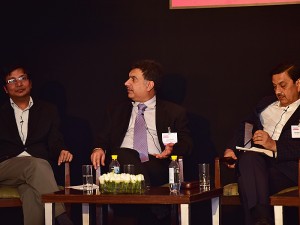 TCI's Jasjit Sethi said that more regulations and higher standards would also increase costs, necessitating a more open, flexible model for logistics
TCI's Jasjit Sethi said that more regulations and higher standards would also increase costs, necessitating a more open, flexible model for logisticsHowever, supply chain costs are set to rise, driven in part by new regulations on safety and emissions, as well as rises in wages, said Jasjit Sethi, CEO of TCI Supply Chain, India’s largest automotive logistics provider. “When you build up infrastructure, you put up tolls – that will also raise costs. New regulations for car carrier size will also make them small and safer, but that will drive up costs. Soon we will also have Euro 4 truck standards, which are also more expensive,” he said.
Sethi referred to the fact that India is apparently set to legislate a standard length of trailer for the road based car carriers of 18.75 metres. There have previously been conflicting rules governing the standard of equipment, and length varies as much as quality and safety, with the majority of trucks more than 22 metres long. This led the licensing government in the state of Haryana, where 80% of equipment is made, to stop issuing certificates to car carriers, according to Vipul Nanda from carrier Gefco-owned Mercurio Pallia and also from India’s newly formed Car Carriers Association (CCA). Given the absence of regulations, the CCA asked the government what the rules for finished vehicle carriers were. There are suggestions that the standard could be set as early as the end of 2015. (Verma was sceptical, however, pointing out that in India it was common to “buy rumours and sell them as news.”)
However, if the standard is set at this length, it will mean carriers are limited to carrying eight cars, or about 25% fewer than with the longer trucks, with a rise in costs of more than 20%. Nanda said it was a heavy investment with a high risk and transport providers are not going to meet the costs without recognition from the OEMs and LSPs.
Car carrier operators, LSPs and OEMs should now be very transparent on the cost of running a legal car transporter when the new rules are introduced, he said. “They should then discipline themselves to follow the government rules,” he continued. “We have landed in this situation because all stakeholders have jointly to be blamed for the current design. When it is implemented OEMs should discourage what is illegal and only use legal trucks."
Rail get on track
Despite these challenges, India’s path to progress should not be ignored. The dedicated rail corridor, while much delayed, does promise significantly greater capacity, and an increase in speed meaning components and containerised finished vehicles will be able to move faster around the country
According to Hari Das Gujrati, director of operations and business development at the Dedicated Freight Corridor Corporation of India, the Western Corridor will focus on container traffic. In its first phase, the Western Corridor will run alongside the existing line on a 963km route between Rewan and Vadodara, on which double stacked trains 1,500 metres in length will be able to travel 100kmph, or 25kmph faster than they are allowed to run today. The average speed is likely to increase to 70kmph from the current 26kmph average. Eventually the Western Corridor will stretch 1,520km.
Rail cars on the Western Corridor will be allowed to be 7.1m in height compared to the 4.2 metres they are currently and wider by 1,200cm. Taken together Gujrati described this as a ‘quantum jump’ in transport capacity, increasing rail’s share of the transport sector from 30% to 45% and saving 457 tonnes of CO2 over a 30 year period. The route will provide good connections to major ports including Gujarat and Maharashtra and is heralded as being a catalyst for growth across industry. Feeder routes will also help reduce transit time and play a dominant role.
 HD Gujarati (left) said that a dedicated rail freight corridor in India would increase average rail speed by three times
HD Gujarati (left) said that a dedicated rail freight corridor in India would increase average rail speed by three timesRail, however, is a more costly form of transport, considered premium freight in India at the moment, with haulage cost having risen 40% last year. One supplier asked Gujrati whether the dedicated rail corridors would be less expensive otherwise companies would be unlikely to shift from the cheaper road option that currently dominates.
“When you talk about cost, it is not just the cost of transport, you have got to take the total cost of shipments into consideration,” responded Gujrati, adding that gains in volume and speed of delivery are inventory factors that will bring efficiencies of scale. He said that the establishment of logistics parks, new multimodal hubs and 3PL services along the corridors would bring down the total cost further.
As reported, India’s automotive rail policy has been somewhat liberalised in recent years, allowing foreign investment and private management of some services. APL Vascor, a joint venture between APL and Vascor, as well as Maruti Suzuki has both invested in rakes.
But progress is still slow, with just a few per cent of vehicles moving by rail in India. Verma has called the AFTO policy a “damp squib” so far.
Bill Villalon, senior vice president, global leader of automotive at APL Logistics and head of the joint venture, said that APL Vascor Logistics had engaged rail providers to level the playing field and have a better pricing structure for rail. He called on Indian Railways for a redesign on costing for AFTO operators (those specifically moving vehicles in India) to achieve that balance and said that only then could each mode naturally adapt and prosper.
“The emerging rail sector needs parity with the truck sector…[.] We still tend to view things on a segment only basis [in India] and don’t have a true multimodal concept,” said Villalon. “The industry needs to optimise the whole process each mode needs to think what their long term goal is.”
Shailendra Singh, general manager of logistics at Maruti Suzuki, agreed and said the there needed to be a more accurately integrated use of assets that removed the inefficiencies currently resulting from the fragmented use of the different transport modes in the country. Without this approach, and a focus on delivering the logical strengths of each mode, the growth and prosperity of the automotive industry will be compromised. OEMs, logistics providers and government all needed to collaborate to make a multimodal system work.
However, Maruti Suzuki is an important piece of the rail puzzle for India, said some delegates. The carmaker is the only other company besides APL Vascor to invest in rail rakes under the AFTO rules. However, it is currently running services from its plants in Delhi southbound, but returning empty rather than hauling other OEMs. Accused of facilitating a ‘national waste’, Singh was questioned on why the carmaker was taking other OEMs on board.
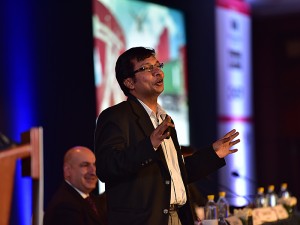 Maruti Suzuki's Shailendra Singh said that the carmaker was increasing multimodal options, even trialling inland barge
Maruti Suzuki's Shailendra Singh said that the carmaker was increasing multimodal options, even trialling inland bargeSingh responded that Maruti was not against moving other carmakers and it would offer capacity. However, currently there were no other carmakers that could fill trains fast enough. “It is more efficient for us to return empty to our plants so that we can keep moving our inventory, rather than waiting longer for trains from the south,” he said.
Path to efficiency
To tackle infrastructure and efficiency lags, executives pointed to a number of strategies at both government and industry level to improve automotive logistics. Julian Bevis said that there needs to be a collective approach by private companies and government, and to a degree a move away from strict regulation and toward free market enterprise.
“The industry needs to pull together and present a cohesive picture to policy makers in government so they actually know what the industry needs,” he noted, adding that it was only through presenting a clear picture to the government of what the problems were that those problems could be properly addressed. There also needed to be a more cohesive approach to the logistics industry itself because too often the progress made in one direction – such as port investment – has been let down by a lack of attention further down the line.
According to Bevis, one of the main KPIs in assessing effective infrastructure is the liner shipping connectivity index, which takes into account how a port is linked to inland routes and modes. India scores low and while the government is now addressing the problem it needs to get a move on if growth in the car market is not to be scuppered by costly inefficiencies.
“Build ports, yes, but they need to be connected to the market,” he said.
Jasjit Sethi had several suggestions to improve India’s efficiency at the practitioner level, particularly around more collaboration in the industry. He suggested that carmakers had to become “less sentimental” about some of their logistics and transport operations, and allow 3PLs to hand more business and find cross-sector efficiencies.
“Especially in vehicle logistics, we talk about 3PLs in the broad sense, but we don’t really practice that,” he said.
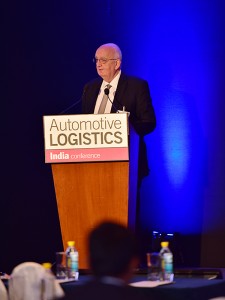 FICCI's Julian Bevis said that India suffered from a lack of proper inland connections to its ports
FICCI's Julian Bevis said that India suffered from a lack of proper inland connections to its portsSethi pointed to practices that would help the sector, such as allow different providers to run main line hauls versus the shorter, local routes, this way they could optimise routing and consolidation. He also suggested that manufacturers started to move towards “decoupling” trailers from the tractor, which would allow logistics providers to drop off load and then quickly move to other nearby plants to pick up trailers for onward delivery. It would allow drivers to greatly increase the amount of kilometres they drive per week, something that Sethi said many companies need to do if they are going to survive as costs rise.
Success story at Mumbai
The conference offered an example of an infrastructure development that has already improved efficiency, at least for vehicle exports. Mumbai Port Trust has been working on a facility development project with Ashok Leyland, India’s second largest commercial vehicle make, and WWL. According to Gur Prasad Kholi, managing director for India at WWL the port needed to develop a facility with global standards for commercial vehicle exports, including in terms of predictability, quality and speed. WWL worked with state bodies to get approval on the development within the port. Work on the project began on June 10th this year and was complete by August 18th with all clearances and permission expedited. The two month delivery on the project was all the more remarkable given it was completed during the monsoon season in that region of India.
The new facility is now just 5km from the vessel loading point compared to the previous one Ashok Leyland was using, which was 54km away, meaning much improved punctuality and quality assurance for the delivery of the vehicles to the point of export. The facility has greater capacity for parking, accommodating up to 1,000 units with a covered area for greater protection, a place for quality checks and the ability to make double ramp loading onto the ships.
As part of the development Mumbai port now has two dedicated berths covering an area of 30,000 sq.m. According to Gautem Dey, senior deputy traffic manager at MBT, there has been a 50% improvement in loading time. That in turn benefits the ocean services provider, which can turn its vessels around in faster time.
There are now 180,000 vehicle units moved annually at MBT but further developments ahead could increase that number significantly to 300,000 in just a few years. As volume increase, the port also has plans to build a multi-story car park.
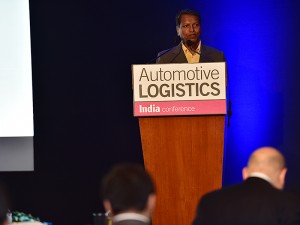 Gautam Dey said that Mumbai Port Trust could see export volumes reach 300,000 vehicles in the coming years
Gautam Dey said that Mumbai Port Trust could see export volumes reach 300,000 vehicles in the coming yearsDey also said that government-owned port had formed a core team with representatives from carmakers Maruti Suzuki, Tata Motors, VW and GM dedicated to tackling issues relating to vehicle damage on road transport and to make the process of delivery to the port seamless. There are also plans afoot to build a multi-story car part at the port for which MBT is inviting tenders. Dey said the developments at the port for vehicle handling would reduce export costs there.
“We have been hearing a lot about Indian infrastructure and its impediments but here we have a good example of how it can work in conjunction with the government,” said Kohli. “This is a great sign for all of us and we’re proud to work with MBT. I hope others will take advantage of this.”
He added that the average loading at MBT, which is now 150 per hour, puts it in a league with some of the best ports in Asia. Singapore, for example, has an average rate of 150-200 loads per hour.
Still waiting for better days
With Automotive Logistics India now its 9th year, it was clear that the conference would not be complete without lamenting the lack of the GST, which has been anticipated every single year. The Modi government had promised to fast track the reform, but it has hit snags in the parliament and in negotiations with state governments.
Though delayed, many still anticipate that its arrival will be transformative. Rajiv Bajaj, vice-president and partner at Nomura Research Institute India said that GST implementation would be the economy’s “defining moment”.
“The GST will spur very high confidence in the economy. We will see investments and potential spike in automotive and logistics,” he said.
The waiting, however, is not yet over, something a feature of the Indian automotive logistics scenario. And for all their frustrations, officials and executives in the country think that better times are close at hand, with good developments happening or imminent.
 WWL's Gur Prasad Kohl said he could see evidence of a more open, engaged attitude in the Indian government
WWL's Gur Prasad Kohl said he could see evidence of a more open, engaged attitude in the Indian governmentWWL’s Gur-Prasad Kohli, for example, pointed to the expediency of Mumbai Port Trust terminal and the cooperation offered by government officials as evidence that things were starting to change under the Modi. Kohli also pointed out that cabotage restrictions had been lifting for coastal shipping between Indian ports, which opens the way for coastal shipping. Although progress has been slow so far, the potential for development is there.
Bill Villalon from APL Logistics pointed out that India was ahead of other emerging market, such as China, that do not allow private or foreign companies to run rail services.
There are also further government plans in the pipeline to improve multimodal logistics under the direction of the National Institution for Transforming India, a policy think-tank established by the Modi government to replace the Planning Commission. HD Gujrati said it would take five or six years for better multimodal integration to start paying dividends. That included plans for multimodal hubs on the Ganges, a first move in exploiting the 4,500km of waterways the country has to offer. Maruti Suzuki has already conducted trials into.
“Multimodal hubs are the need of the hour,” said Gujrati.
Maruti’s Shailendra Singh, meanwhile, speculated that within two years more economical point-to-point multimodal deliveries would make an appearance, rather than single mode round trips that are costly because the assets are usually unused on the return journey.
“We are paying for the full round trip even if we are not using it,” he complained. “Point-to-point can make profit through integration. Ask the providers today and they say point-to-point is impossible but someone will do it in two years using a multimodal solution.”
 Rajiv Bajaj predicted that the long-awaited GST would be a 'defining moment' for India
Rajiv Bajaj predicted that the long-awaited GST would be a 'defining moment' for IndiaRajiv Bajaj also suggested that logistics and supply chain management would “rise up the agenda” in India as things like the GST and further growth took root, predicting that it would become a function viewed as strategically as sales or purchasing, especially as digital technology and a more open market connected carmakers more closely to their dealers and suppliers. But this was also something that he felt OEMs should take charge of.
“People are showing signs of being open, which is positive,” he said. “Technological developments will come and it will increase efficiency between suppliers and dealers. OEMs need to step up the agenda as they have more control over it."
The next conference in the Automotive Logistics series of events will be Automotive Logistics Mexico in Mexico City on January 26-28.
The next conference to take place in Asia will be Automotive Logistics China in Chengdu in April.



































